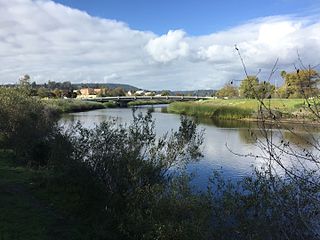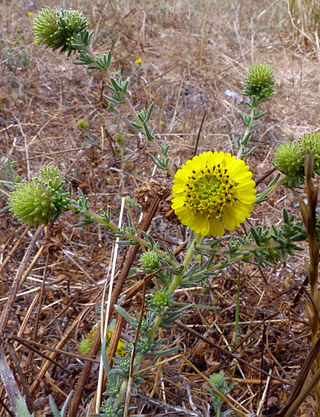Related Research Articles

The jaguar is a large cat species and the only living member of the genus Panthera native to the Americas. With a body length of up to 1.85 m and a weight of up to 158 kg (348 lb), it is the biggest cat species in the Americas and the third largest in the world. Its distinctively marked coat features pale yellow to tan colored fur covered by spots that transition to rosettes on the sides, although a melanistic black coat appears in some individuals. The jaguar's powerful bite allows it to pierce the carapaces of turtles and tortoises, and to employ an unusual killing method: it bites directly through the skull of mammalian prey between the ears to deliver a fatal blow to the brain.

The cougar, also known as the panther, mountain lion, catamount and puma, is a large cat native to the Americas. It inhabits North, Central and South America, making it the most widely distributed wild, terrestrial mammal in the Western Hemisphere, and one of the most widespread in the world. Its range spans the Canadian Territory of Yukon, British Columbia and Alberta provinces, the Rocky Mountains and areas in the Western United States. Further south, its range extends through Mexico to the Amazon Rainforest and the southern Andes Mountains in Patagonia. It is an adaptable, generalist species, occurring in most American habitat types. It prefers habitats with dense underbrush and rocky areas for stalking but also lives in open areas.

The Santa Cruz Mountains are a mountain range in central and Northern California, United States, constituting a part of the Pacific Coast Ranges. They form a ridge down the San Francisco Peninsula, south of San Francisco. They separate the Pacific Ocean from the San Francisco Bay and the Santa Clara Valley, and continue south to the Central Coast, bordering Monterey Bay and ending at the Salinas Valley. The range passes through the counties of San Mateo, Santa Clara, and Santa Cruz, with the Pajaro River forming the southern boundary.

The San Lorenzo River is a 29.3-mile-long (47.2 km) river in the U.S. state of California. The name San Lorenzo derives from the Spanish language for "Saint Lawrence" due to its reported sighting on that saint's feast day by Spanish explorers. Its headwaters originate in Castle Rock State Park in the Santa Cruz Mountains and flow south by southeast through the San Lorenzo Valley before passing through Santa Cruz and emptying into Monterey Bay and the Pacific Ocean.

The Guadalupe River mainstem is an urban, northward flowing 14 miles (23 km) river in California whose much longer headwater creeks originate in the Santa Cruz Mountains. The river mainstem now begins on the Santa Clara Valley floor when Los Alamitos Creek exits Lake Almaden and joins Guadalupe Creek just downstream of Coleman Road in San Jose, California. From here it flows north through San Jose, where it receives Los Gatos Creek, a major tributary. The Guadalupe River serves as the eastern boundary of the City of Santa Clara and the western boundary of Alviso, and after coursing through San José, it empties into south San Francisco Bay at the Alviso Slough.

Coyote Valley is an area located in a narrowing of the southern Santa Clara Valley, in Northern California. Coyote Valley is approximately 7,400 acres (2,995 ha) in size and largely composed of farmland, orchards, open space preserves, and homes. Coyote Valley is generally divided into three sections: North Coyote Valley, the unincorporated village of Coyote, California, and South Coyote Valley.
The Bay Area Open Space Council was a network of 65 nonprofits and public agencies San Francisco Bay Area founded in 1990 by a group of land conservation practitioners to provide information, tools, and connections for its members. Though the Open Space Council's office was located in Berkeley, California, member organizations represented all nine counties of the San Francisco Bay Area plus Santa Cruz County.

Stevens Creek is a 20.9-mile-long (33.6 km) stream in Santa Clara County, California. The creek originates in the Santa Cruz Mountains on the western flank of Black Mountain in the Monte Bello Open Space Preserve near the terminus of Page Mill Road at Skyline Boulevard. It flows southeasterly through the Stevens Creek County Park before turning northeast into Stevens Creek Reservoir. It then continues north for 12.5 miles (20.1 km) through Cupertino, Los Altos, Sunnyvale and Mountain View before emptying into the San Francisco Bay at the Whisman Slough, near Google's main campus.

The Golden Gate Biosphere Network is a voluntary coalition of federal, state, and local government agencies, nonprofit organizations, universities, and private partners within the Golden Gate Biosphere region. The Network aims to protect the region's biodiversity and conserve its natural resources, enhancing quality of life for local residents. The Network has been part of the UNESCO Man and Biosphere Programme since 1988 and is part of the US Biosphere Network and EuroMAB. It is recognized by UNESCO due to the significant biodiversity of the region, as well as the Network's efforts to demonstrate and promote a balanced relationship between humans and the biosphere.

Holocarpha macradenia, commonly known as the Santa Cruz tarplant, is an endangered plant endemic to Northern California. Alternative common names for this plant are Santa Cruz tarweed or Santa Cruz sunflower.

The North American cougar is a cougar subspecies in North America. It is the biggest cat in North America. It was once common in eastern North America and is still prevalent in the western half of the continent. This subspecies includes populations in western Canada, the western United States, Florida, Mexico and Central America, and possibly South America northwest of the Andes Mountains. It thus includes the extirpated eastern cougar and extant Florida panther populations.

The Los Gatos Creek runs 24 miles (39 km) in California through Santa Clara Valley Water District's Guadalupe Watershed from the Santa Cruz Mountains northward through the Santa Clara Valley until its confluence with the Guadalupe River in downtown San Jose. The Guadalupe River then continues onward into San Francisco Bay.

Puma is a genus in the family Felidae whose only extant species is the cougar, and may also include several poorly known Old World fossil representatives. In addition to these potential Old World fossils, a few New World fossil representatives are possible, such as Puma pumoides and the two species of the so-called "American cheetah", currently classified under the genus Miracinonyx.

Elkhorn Slough is a 7-mile-long (11 km) tidal slough and estuary on Monterey Bay in Monterey County, California. It is California's second largest estuary and the United States' first estuarine sanctuary. The community of Moss Landing and the Moss Landing Power Plant are located at the mouth of the slough on the bay.

The Coastal Science Campus of the University of California, Santa Cruz consists of five main institutions: UC Santa Cruz's Long Marine Laboratory, UC Santa Cruz's Coastal Biology Building, the NOAA Southwest Fisheries Science Center, the Seymour Marine Discovery Center, and the California Marine Wildlife Veterinary Care and Research Center.

Earthwatch Institute is an international environmental charity. It was founded in 1971 as Educational Expeditions International by Bob Citron and Clarence Truesdale. Earthwatch Institute supports Ph.D. researchers internationally and conducts over 100,000 hours of research annually using the Citizen Science methodology. Earthwatch's mission statement states that the organization "connects people with scientists worldwide to conduct environmental research and empowers them with the knowledge they need to conserve the planet." As such, it is one of the global underwriters of scientific field research in climate change, archaeology, paleontology, marine life, biodiversity, ecosystems and wildlife. For over fifty years, Earthwatch has raised funds to recruit individuals, students, teachers, and corporate fellows to participate in field research to understand nature's response to accelerating global change.
Felidae Conservation Fund (FCF) is a California-based non-profit organization dedicated to preserving wild cats and their habitats. The organization supports and promotes international wild cat research and conservation by collaborating on field research projects, partnering with other environmental organizations, and developing community outreach and education programs.

The Cheadle Center for Biodiversity and Ecological Restoration (CCBER) is a research center under the Office of Research at the University of California, Santa Barbara (UCSB) whose mission is to preserve regional biodiversity and restore ecosystems on campus lands. CCBER has three main functions: curation and preservation of natural history collections, native coastal ecosystem and habitat restoration on campus lands, and education and outreach for both UCSB students and local community schools.

The Wallis Annenberg Wildlife Crossing is a vegetated overpass spanning the Ventura Freeway and Agoura Road under construction at Liberty Canyon in Agoura Hills, California. The bridge will be one of the largest urban wildlife crossings in the world, connecting the Simi Hills and the Santa Monica Mountains over a busy, 10-lane freeway.
Stunt Ranch Santa Monica Mountains Reserve, also known as UCLA Stunt Ranch, is a 121-hectare (310-acre) University of California Natural Reserve System reserve and biological field station located in Los Angeles County. The reserve protects habitat surrounded by the Santa Monica Mountains National Recreation Area. The address is 1201 Stunt Road, Calabasas, California.
References
- ↑ Fimrite, Peter (January 11, 2009). "Tracking Mountain Lions-For Their Own Good". San Francisco Chronicle .
- 1 2 3 "Bay Area Puma Project information page". Felidae Conservation Fund. Archived from the original on 2008-07-23. Retrieved February 18, 2009.
- ↑ Gorn, David (January 12, 2009). "Tracking Urban Lions". KQED 88.5 FM. Archived from the original on June 26, 2009. Retrieved February 18, 2009.
- 1 2 "UC Santa Cruz to lead pioneering study of pumas in the Santa Cruz Mountains" (Press release). UC Santa Cruz. May 6, 2008. Archived from the original on 2009-06-26. Retrieved February 18, 2009.